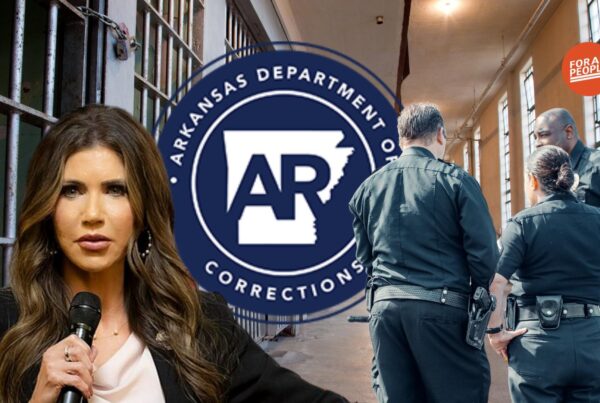A few weeks ago, the Little Rock School District, City of Little Rock, and Little Rock Food Commission asked the community for donations to wipe out $175,000 of food debt for students. Seniors were the priority; rumors abounded that debt-holding seniors wouldn’t be able to walk at graduation ceremonies, though LRSD later debunked that. Collectively, seniors held about $15,000 worth of food debt; by May 20, LRSD had received enough donations to wipe out most, if not all, of seniors’ debt. It was, undoubtedly, a win for LRSD students.
But that story doesn’t come close to describing the full picture of school food debt. There’s a history here going back to at least 2017. It’s a story of how nominally good laws have unintended consequences; how good intentions can cause harm half a decade later; how COVID’s insidious tentacles kept spreading, even after masks stopped being a part of our everyday lives; and how a lack of political will at both the federal and state levels created a problem that quietly built and built and built until the levees began to crack.
The problem of student food debt does not discriminate between rural and urban districts or between Delta and Ozark districts. It does not discriminate between wealthy and poor districts. One school nutrition director told us that of the 255 school public school districts, all of them – all of them – have food debt. From Rogers to Monticello, Little Rock to El Dorado, feeding students at school has become an issue that transcends party and class. It’s an issue that seems to reflect broader problems in state and federal politics.
And, of course, it’s an issue that affects our most important constituency: our students. Stephanie Walker-Hynes, the nutrition director for the Little Rock School District, said that the problem of school food debt takes “away the human aspect of what we should be focusing on: allowing children to learn with food in their stomachs.” While aspects of their situations can vary, every nutrition director I spoke with said fundamentally the same thing: kids with full stomachs learn better, and it’s our responsibility to ensure those stomachs are full.
So why aren’t those stomachs full, and why are kids carrying debt just to eat?
The Problem Starts Cooking
In 2019, Representative Andy Davis (R-Roland) passed Act 428, the Hunger Free Students’ Bill of Rights Act. Among other things, the act required districts to feed every student equally; in other words, students on free and reduced lunch could not be fed a different meal from other students, they could not be identified as students on free and reduced lunch, and they could not be denied meals or snacks other students received, even if they had incurred breakfast or lunch debt.
This is, on its face, an excellent law; as we reported when we discussed SB59/Act 123 from the 2025 legislative session, the evidence for ensuring students learn on full stomachs is overwhelming; kids whose stomachs aren’t rumbling learn much, much better than hungry kids. However, the legislature failed to attach a funding mechanism to this bill. Put otherwise: school districts couldn’t deny students food, but also had no help from the state to cover the difference for students who couldn’t afford meals.
The problem worsened in the post-COVID years. In a 2023 report, No Kid Hungry succinctly described the situation: the United States Department of Agriculture (USDA), seeing a huge increase in poverty in the early COVID days, subsidized free school meals across the nation. Not a single student in public school paid for food from March 2020 through June 2022.
This was, undoubtedly, a huge step in the right direction, but it wasn’t permanent. When the 2022 school year closed out, many school districts had gotten used to the federal subsidy and weren’t sure how to cover the difference when that subsidy went away. Remember that districts can’t deny any meal to a student; after COVID, even students whose families could otherwise afford school meals often wouldn’t pay.
The problem became two-pronged: Arkansas school districts were required to feed every kid, but couldn’t do more than send letters to parents of kids that had food debt. At the same time, they weren’t getting much – if any – support from the state to cover the increasing numbers of students using the free and reduced lunch programs.
Nibbling At The Edges Doesn’t Fix Bigger Problems
To their credit, some legislators understood the direction this was going and have passed a few laws over the past few sessions which alleviated the problem. In 2023, the General Assembly passed Act 656, which covers the reduced-price copay for qualifying students, letting them eat for free instead. We wrote approvingly of this session’s SB59/Act 123 that pays for free breakfast to all Arkansas students, regardless of socioeconomic status.
There also were federal grants from the United States Department of Agriculture that assisted some districts with buying local proteins and fresher fruits and vegetables, which are normally quite expensive. These local options are both typically more nutritious and keep money in the local economy, so everyone wins! Recently, however, the Trump administration has terminated many of those grants, and some of the district nutrition directors I spoke with told me the difference will be tough to make up.
Amanda West of Monticello is one of those nutrition directors. In the last few years, the percentage of students on free or reduced lunch in her area has risen from about 42% to 69%. This number affects how much money districts can get from the Community Eligibility Provision program, a key federal subsidy that helps districts that have at least 25% of students from low-income families, keep up with the rising price of food. Like the local subsidy grants, this program doesn’t solve all of a district’s problems, but it is part of the scaffolding holding together vulnerable nutrition programs like West’s. However, the Trump administration may consider cuts to this program as well, pushing hundreds of thousands of students toward increased food insecurity.
Stephanie Walker-Hynes, Little Rock’s school nutrition director (though she refers to herself as the district’s “leading lunch lady” with no small amount of pride) is also the vice-president for the Arkansas School Nutrition Association, an organization that helps nutrition directors around the state win food support grants, find protein and produce suppliers, and plan healthy menus; in that role, she has a bird’s eye view of common problems across the state and pulled back the curtain for me on what might be the biggest driver of school food debt: school nutrition programs do not use school district monies. The financial streams are completely separate.
In the past, federal grants mostly covered students on free or reduced lunch, and kids who could pay did so, so nutrition programs generally broke even. But with the passage of Act 428 in 2019, the law requiring schools to provide meals to students even if they can’t pay, nutrition programs began to lose substantial revenue. Harsher guidance and pulled subsidies from the USDA are exacerbating the problem.
“It’s Something We Owe Our Children”
To be clear, every nutrition director I spoke to wanted to be very clear about one thing: kids in schools deserve to be fed. Glenda Haley, who works with 25 districts in North Central Arkansas but is based in Batesville, said, “This is an adult problem that’s affecting our kids. It’s not a child’s responsibility to wonder where their next meal is coming from.” Amanda West and Stephanie Walker-Hynes told me the same thing.
The core problem, as laid out above, lies with the way the legislature structured Act 428 of 2019. While all the nutrition directors supported the fundamental principle motivating the act – I can’t emphasize enough that school children learn better on full stomachs, so no student should go hungry – the lack of a funding mechanism started a snowball effect that they just struggle to deal with.
Two other problems have cropped up. First, the number of free and reduced lunch applications determines how much money the nutrition programs receive through subsidies, which helps them cover overall costs. Let me run you through how this problem works.
Margie Bowers, nutrition director for Rogers School District, says her program has about $490,328 in debt as of May 16, down from about $600,000 earlier in the year. Both Rogers and Little Rock have prioritized paying down seniors’ debts so they can graduate debt-free, but that’s a drop in the bucket for the Rogers debt. She’ll have to ask the district to eat about $65,000 this year because nutrition programs can’t solicit repayment from “inactive students” from families that have left the district, but they’re also not permitted to run a balance per USDA rules, so they have to ask districts to cover the distance so each school year ends in the black.
For a relatively well-off district like Rogers, that’s a hit, but doable. For poorer districts like Monticello and Batesville, that request could be crippling without some kind of state aid. And remember, nutrition programs don’t have the same funding mechanisms as the school district, so any kind of millage increase doesn’t trickle down to them; in fact, when families leave the district, there’s often a counterintuitive net increase in cost.
Rogers has seen decreased enrollment the last few years (though it has rebounded a bit this year), and many districts have started trending in the same direction. The amount of federal aid that comes through the Community Eligibility Provision program and other state programs depends on how many families fill out applications for free and reduced lunches and are approved. Fewer free and reduced lunch students means less money from state and federal government agencies.
Many parents, however, don’t know or remember that they have to fill out new applications every year, especially if their child starts at a new school halfway through the year. The student will be fed regardless, remember, so there’s really no consequence that will directly affect the family. The effects hit the district’s nutrition program down the line.
LEARNS has also contributed to this problem. Parents making use of the $7,000 voucher don’t just take money out of the school district; it reduces the number of students paying for lunches or filling out free and reduced lunch applications. Again, there’s no direct hit to the school nutrition programs, but downstream impacts are obvious. Some districts can barely cover teacher salaries and maintenance, let alone free food for students.
A few nutrition directors I spoke with mentioned one final, heartbreaking reason for the decreasing number of free and reduced lunch applications: the increased presence of ICE, especially in the northern half of the state. Parents are fearful that ICE will gain access to the applications and target them. One said that public schools should be a safe zone for students and their families.
The second problem is a familiar one: everything just costs more now. Bowers, the Rogers nutrition director, said that her main vendor informed her that prices will likely increase by a whopping 20%. Because these programs are distinct from the school district, they also struggle to provide benefits to workers, making jobs less attractive. Furthermore, food safety standards are higher in school nutrition programs than in, say, the fast food industry, which also adds cost. Equipment ages and has to be repaired or replaced more frequently than most restaurants to meet those increased food safety requirements.
Relying on these programs to break even is no longer sustainable, but as Bowers and Haley both told me, food should simply be a part of students’ education. Haley asked a rhetorical question during our conversation: “We feed our prisoners for free, but charge our children?”
What Do We Need to Serve to Fix This?
Fortunately, every nutrition director I spoke with agreed on the solution: make lunch completely free, like the General Assembly did with SB59/Act 123. Unfortunately, like many simple solutions, that’s easier said than done. Sen. Clarke Tucker (D-Little Rock) co-sponsored the free breakfast bill with Sen. Jonathan Dismang (R-Searcy) in a rare but effective bit of bipartisan cooperation. He told me he’s very proud of the three-step approach the Legislature has taken over the past few sessions to reduce barriers to school meals, and the free breakfast bill was a “big step in the right direction.” He also agreed that free lunch is the next step.
Free lunches, however, will represent a much bigger price tag. Walker-Hynes, Little Rock’s nutrition director, told me less than 20% of LRSD’s food debt came from breakfasts. Most students eat at home or skip breakfast altogether in favor of sleeping in. Dismang estimated the price tag for free breakfast will be $14.7 million, all of which will come through a combination of federal funds, private grants, and taxes on medical marijuana. Some back of the napkin math puts the price tag for free lunches at roughly $73.5 million, if every district’s ratio of breakfast to lunch debt is roughly comparable to LRSD. While the exact price tag of free lunches is hard to estimate, we can be sure it’ll be much higher than free breakfast.
Sen. Tucker expressed optimism that both the Governor and the Legislature have a “strong commitment” to addressing the problem, but acknowledged that the increased price tag will be tougher for legislators to swallow. At least eight states have passed some version of free school lunches and more are considering doing so, but these programs are costing more than expected. Sen. Tucker said that the medical marijuana taxes won’t cover both free breakfast and lunch, so a different funding source needs to be identified. He stressed that the bipartisan commitment to dealing with the problem remains strong, however; it’s a matter of working out the details. But those details are going to be thorny.
I don’t doubt that statement. During debate on the free breakfast bill, Sen. Dismang noted this is part of a student’s education, just like a district-provided laptop or tablet; it’s clear he and Governor Sanders are aware of the problem and take seriously the evidence that good, nutritious food throughout the day is a worthy expense that contributes to an effective education.
Nutrition directors across the state agreed, but were more pessimistic about the chances of a solution materializing any time soon. Without a special session, the soonest any substantial legislation can take effect is Fall 2027. Given the loss of federal programs, every nutrition director expects their costs to balloon. The loss of federal funding was particularly frustrating to Margie Bowers, the Rogers nutrition director. She said that “if there’s one government program where the money goes where it’s supposed to, it’s child nutrition. There’s no waste.” With thirty years worth of experience, it’s hard to disagree with her.
Walker-Hynes spoke frankly about the problem’s scope and potential solutions, even though public education has started to feel lonely and desperate in this state. “It is grim. We don’t see any hope right now. But we’re not going to stop doing what we do.”
What these nutrition directors do is feed children.
Stephanie Walker-Hynes, Margie Bowers, Glenda Haley, and Amanda West are all dedicated employees who have worked in child nutrition, combined, for roughly 120 years. They’re not about to stop any time soon, because, to put it in West’s words, “Meals should be a part of education.” No matter what, no nutrition director across the state will let kids go hungry on their watch, and it should be noted that, despite stereotypes, school nutrition has increased massively in quality since 2010. It is genuinely healthy for kids to eat at school, especially if they live in food deserts. Arkansas wouldn’t know anything about that, would it?
But the realities of the situation are catching up. Walker-Hynes said she’s been forced to think and work like a business person, even though nutrition programs aren’t businesses. Without significant, sustained help from the top, debts will continue to accrue. Food will decrease in quality.
And kids, at the end of the day, will suffer the consequences of our failures.
An earlier version of this story stated that debt-holding seniors would not be able to participate in graduation ceremonies. This story has been updated to reflect LRSD’s statement to the contrary.





